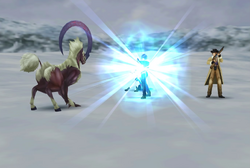
Battle in Final Fantasy VIII.
- For the weapon in Final Fantasy V, see: List of Final Fantasy V Weapons#Battle Axe
A Battle, also known as a Fight, or an Encounter, is an event in the Final Fantasy series, and one of the key modules that make up a game. A battle can be triggered from either the Field or World Map modules, most commonly through the random encounter system. In simple terms, a battle is commonly made up of a player party and an opposing party. The common objective of a battle is to defeat the opposing party by utilizing the abilities on the Command menu. A unit is removed from battle when its HP stat reduces to 0, imposing the Knocked Out status.
Battles are made up of a large number of intricate systems and devices that affect the way the game is played. Each game is usually defined by its primary system, known simply as its Battle System. Different battle systems vary on the Time gauge, or lack thereof, and the order of attacks launched by each individual unit. All of the games have a Status bar that include the player's important stats such as HP and MP. On this bar is a Command window that appears when a party unit has a chance to select a command. The commands have different effects, affecting a varying number of targets, and may make use of different Elements and the Statuses. Also, outside of battle players can incorporate Support Abilities into the mix where a player automatically has an in-battle effector equipped.
While the enemy party only varies in its abilities, and in some games, its level, the player party has many more components that affect their performance in battle. The player's Equipment allows them to use different strength and strains of Weapon for different purposes. They also have different types of Armor to protect against enemy attacks. Many games in the series also emulate an Accessory option, which allows players to add Support Abilities and resist or absorb different statuses and elements.
Further things that develop as the party progresses are the leveling systems. In the majority of games in the series, players increase Levels based on the Experience Points gained, and in a smaller number of games, abilities are learned by gaining Ability Points. After the player party defeats the enemy party, they will receive these rewards, often in addition to Gil and any item drops the enemy may harbor. These are often displayed in the Battle Results screen. If the player should lose, with a few exceptions, the player will receive a Game Over and have to load their previously saved game progress.
Encountering
A battle can be entered from either the World Map screen or the Field screen. The most common type of encounter on the World Map is the random encounter, however some games have a number of fixed encounters on the World Map, such as Ruby Weapon, Emerald Weapon, and Ultimate Weapon from Final Fantasy VII. The field is where most forms of battle encounters are engaged, particularly in dungeons.
Random encounters
Random encounters are the primary method of engaging in battles in most games in the series and the primary source of Level Grinding. The World Map is covered in random encounters over different terrains. Usually encounters are avoided when traveling in vehicles. Different places have different encounter rates, for example, the lower areas of the Deep Sea Research Center in Final Fantasy VIII have a more intense encounter rate on the descent to Ultima Weapon, but after defeating it, there are no encounters on the way out. There are also a number of support abilities that affect the encounter rate, being Encounter Half and Encounter None.
Sometimes there are one-off random encounters such as the Mystery Ninja found in forests in Final Fantasy VII, Ramuh found in the forest west of Istory in Final Fantasy V, or the Friendly Enemies of Final Fantasy IX. These often yield results, such as the recruiting of a new party member, the recruiting of a summon, or other healthy results.
Fixed encounters
Fixed encounters refer to encounters fought when a player moves into a set position. There are two primary types: the invisible, and the visible. An example of invisible fixed encounters are the Trap Rooms in Final Fantasy II, and the entire left area of the first floor of the Cavern of Earth in the original Final Fantasy. These are often used to protect Treasure Chests or to hinder progress through dungeons. Visible fixed encounters are visible things the player can see before they move into it. Visible fixed encounters are used to allow the player to choose their route to avoid traps, such as the webs in the Cave of the Gi that trigger an encounter against the Stinger enemy in Final Fantasy VII. They are also so the player knows there is something to gain, like the Cerberus boss in Final Fantasy VIII that leads to obtaining the Cerberus summon.
Some fixed encounters remain after the battle is engaged, while others disappear after being encountered once. One-time only fixed encounters are used for boss battles or semi-boss battles, like the Iron Claw boss battle in Final Fantasy V, or the Four Fiends encounters in Memoria from Final Fantasy IX. Permanent fixed encounters can be exploited as a quick source of grinding as the battle can be re-entered in less steps than random encounters, and often hold more rewards.
Script encounters
Script encounters differ from normal fixed encounters as they are not an instant battle. Instead, after moving into a trigger area, or onto the trigger screen, a scene ensues involving dialogue. These are often used for many boss battles. An example of this is when the player returns to Baron and the party converse with Baigan before encountering him in a boss battle.
Action encounters
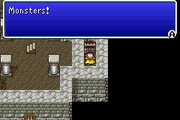
Monster-in-a-box in Final Fantasy IV.
Action encounters are encounters that require the pressing of an action button before a battle occurs. An example of this are the Pirate enemies in Pravoka, encountered when the player talks to Bikke in the original Final Fantasy. Due to the options involved, the player can easily withhold from these battles before they happen and Menu grind before starting them. Action encounters are a common method for boss battles.
Action encounters are exploited by the game through Treasure Chests spiked with Monster-in-a-box.
Optional encounters
Optional encounters are a subordinate of an action encounter. Optional encounters, in terms of action encounters, refer to battles that can be avoided through the options the player may choose. An example of an optional encounter is the submarine crew in Final Fantasy VII the player only has to battle if they choose the option to. A conditional optional encounter is whether the party has completed Yuffie's side quest in Wutai in the course of Final Fantasy VII. If this is the case, the party can avoid the battle with the three Turks underneath Midgar.
Battle layout
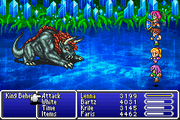
Battle in Final Fantasy V.
Battles use a basic layout in most games where the player party and enemy party are set in a formation, normally on opposite sides of the screen, on top of a battle background. The bottom of the screen holds the status bar, and a bar at the top of the screen reads enemy ability names and dialogue when necessary.
Player party
Template:See Also The player party is comprised of a number of playable characters. The standard is three, but varies to a maximum of five. The series' spin-off games that are of different genre often have just one party member in a battle, the sole playable character throughout the game. The earlier games of the Final Fantasy series organize the players into one of two rows, the Front Row and the Back Row. The Front Row is often considered the Normal status, where attack damage and damage endurance are at a normal rate. Moving a player to Back Row will decrease damage dealt to enemy units, while decreasing the damage inflicted by the enemy to the player unit. Accuracy rates may also differ in some games, and the Long Range support ability found as its own ability, or sometimes automatically equipped to weapons, allows players in the Back Row to deal damage as if they were on the Front Row.
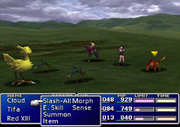
Player party faces a Chocobo's party in Final Fantasy VII.
The player party is built up of differing units. There is usually an amount of user customization in how the player wants to manipulate their units, however there is also a level of initial individual differences, as well as different level progression in different areas. For example, in Final Fantasy II the player has three main playable characters throughout the game, but while any character can equip any weapon, Guy has the most Strength, HP, and Stamina, suiting him for a front row, strong weapon wielder. Maria starts off with a higher Intelligence stat making her better suited as a Black Mage, and her low HP suits her for a Back Row positioned Bow wielder, as her equip defaults suggest.
Other games give more inclination into what a character is best suited for by limiting their equips. In the original Final Fantasy, the job system allows the player to choose jobs for their characters. This then pre-defines what Magic they can learn, and what equipment they can equip. On the opposite end of the scale, other games with the job system may give less inclination into what each character is best suited for. Final Fantasy V allows each character to switch job class as the game progresses, with little individual differences between the characters, allowing them to customize each character's role in battle.
Enemy party
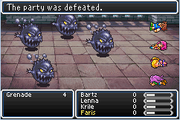
Enemy party defeating the player party in Final Fantasy V.
There are a number of different compositions the enemy party can appear as in different locations. Each area where random encounters are available will have a number of different formation that can be encountered with different encounter rates for each.
The enemy party also uses a row formation in early entries to the Final Fantasy series, albeit with a different functionality. Where the player party can put all their units on the Back Row, this cannot technically be achieved with the enemy party. The enemy party is organized into a formation, units behind other units are on the Back Row, while units without a unit in front of it are on the Front Row. If all units in the Front Row are defeated, the next row behind them becomes the new Front Row and can therefore be attacked for full damage. A player unit can attack an enemy unit for the same physical damage regardless of Row with the Long Range support ability.
While the player party always consist of units with the same cause, an enemy party may have split causes, or a different cause than to defeat the player party. Example of this are the Golem battle in Final Fantasy V, the Chocobo battles in Final Fantasy VII, the UFO? battles in Final Fantasy VIII, and the Friendly Enemies battles in Final Fantasy IX.
Enemies often have fixed stats and don't vary, or progress as the player party progresses meaning the enemies get harder as the player progresses through the World Map. An exception to the rule is Final Fantasy VIII where weaker enemies are still fought towards the start and they get progressively harder, but their HP raises and their Magic gets stronger as the player's Level raises.
Attack formation
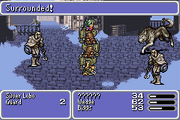
Pincer attack in Final Fanatasy VI.
The term attack formations refers to both the placement of the two parties during a battle and the order of turns. In a normal formation, where the player party is at one side of the screen, and the enemy party is at the opposite, there are three types of battle. A normal battle gives both parties have an equal chance of launching the first attack. In a preemptive attack the player is guaranteed to get the first chance to strike, whereas a surprise attack guarantees the enemy party will strike first.
In the earlier games, the back attack formation has the player party on the left-hand side of the screen instead of the ordinary right-hand side. All the sprites are flipped horizontally so both parties still face each other, however the player party's rows are switched, so units set to the Front Row were on the Back Row and vice-versa. An example of a battle which is always a back attack is the second Scarmiglione battle in Final Fantasy IV. In later games, the player has their back to the enemy formation at the start. An example of a battle that is always like this is the Motor Ball battle in Final Fantasy VII.
Introduced in Final Fantasy VI, side attacks have the party split in two and attack on either side of the enemy. If the sprite's back is to the attacking unit, they will deal double damage, and the sprite will then be flipped. Pincer attacks, also known as ambushes, are the opposite, introduced in the same game, where the enemy attacks the player from both sides. An example of a battle that is always an ambush is the formation of six Touch Me enemies, three either side, fought outside Gongaga in its jungles.
Status bar
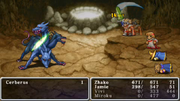
Status bar at the bottom of the screen in the 20th Anniversary version of Final Fantasy.
The status bar holds important information about the player party in it during the battle. It will display the unit's names, their HP and MP stats, and any other necessary information like the Time gauge and the Limit gauge if applicable. The status bar will also clearly define if the player's in Critical status by highlighting the HP in yellow, and in red or gray if the player is Knocked Out.
When a unit's Time gauge is full, or when it is the player party's turn to select attacks, a Command window appears that allows the user to select the unit's commands, often navigated with the famous finger Cursor. There is often a list of four commands, some of which are commands, others lead to skillsets with sub-menus such as Black Magic or Item. Most units have the Attack and Item command by default, in addition to the Defend and Row options that allow the player to take half damage for a round or switch rows. These options are usually found by pressing left and right on the Command window. In earlier games, the player has the Escape command as a turn's action instead of the controller input device that allows the player party to attempt escape during their turns.
Battle background
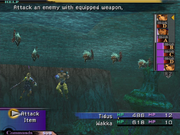
Underwater battle in Final Fantasy X.
The battle background defines where the player is. In the sprite-based games, the camera movement is flat and the background remains the same, perhaps with small animations, while the party units animate over the top. Model-based games often have a moving camera that exposes different parts of the battlefield.
Different field locations have different battle backgrounds relevant to the scenery of the location. The World Map often uses the same battle backgrounds over the entire map depending on the terrain. In the original Final Fantasy, dungeons use the same battle background for all of its levels, except during the boss battle which uses a unique one.
In some of the earlier games, while there are no visible beaches, the player encounters enemies on a beach background by facing a random encounter on the border of an island. In certain locations, some places notably use the wrong battle background for the terrain, such as battling on a grass background when on beach terrain. In games where random encounters exist in the sea when on a boat, the player fights the enemy party on the boat. Oddly, the player party can still escape from these battles, clearly leaving the enemy intruders on their boat.
If the player encounters Emerald Weapon underwater in Final Fantasy VII, they will leave their Submarine and battle it in an underwater background. Due to the problems with breathing underwater, the game gives a timer of twenty minutes to defeat the enemy until they automatically Game Over. The timer disappears if the player has the Underwater Materia, its Japanese name literally being "Underwater Breathing." Underwater battles also occur in Final Fantasy X, limiting the party members to Tidus, Wakka, and Rikku.
Systems
Battle systems
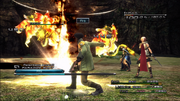
Command Synergy Battle System in Final Fantasy XIII.
The battle systems are the core engine for battles. The battle system defines when a player can take a turn. The original games released on the NES use a Traditional Turn Based system where the battle is fought in rounds. Each unit selects a command, and the Speed decides the order each one fights. The battle system developed further for the SNES era where the system developed into the Active Time Battle system that allows the Speed stat to decide how fast the Time gauge, or the ATB gauge, fills. Active Time Battle battles aren't in rounds, and units attack whenever their Time gauge fills, so the number of attacks from each unit doesn't have to be even.
The Conditional Turn Based system used in the Final Fantasy Tactics games, and in Final Fantasy X. In this system the game uses the Speed stats to create an order of attacks. In this system the amount of time it takes to select a command has no effect over the order the unit attacks as it is always fixed. Statuses such as Haste and Slow affect the order.
The Real Time Battle system used in Final Fantasy XI and Final Fantasy XIV works by removing the encounter systems, and the Battle module is merged with the World Map module where enemies can be found. Players can choose to attack enemies, just as some enemies can choose to attack players.
Abilities
Abilities can be split into two clear types. Support abilities, divided into external support abilities and internal support abilities, or battle support abilities, and Command abilities. Support abilities are automatic abilities, where Command abilities are selectable commands.
Support abilities
External support abilities are either are for the World Map, or abilities like Alert and Encounter None which prevent back attacks and all attacks respectively. The other pool of support abilities keep fixed statuses on players during the battle. These include counter abilities, or reaction abilities such as the basic Counter for physical attacks, Magic Counter for returning spells, and Auto Potion which counters an attack by using a Potion on their self. Other abilities keep a status inflicted during the entire battle, such as Auto Regen for Regen, and Auto-Reflect for Reflect. Another type of support ability are other effectors, like Chemist increasing the potency of restorative items, and Half MP reducing the cost of spells.
Command abilities
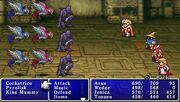
Choosing a command in the 20th Anniversary version of Final Fantasy.
Command abilities often refer to the items shown on the primary Command window. Commands that open up into further skills are known as Skillsets. Due to this, the Item command is known as a skillset, where the items are its abilities. Command abilities have many different effects, physical or magical, non-elemental or elemental, or status-inflicting. Some abilities like Defend and Hide allow the player to avoid damage.
Most games also have a Limit Break system which works differently in every game. It is not always a Command Ability, but when it is, sometimes it becomes active when a Limit Gauge is filled, or a when a player is in Critical status. Final Fantasy X has its own system which involves many different methods which can be set with Overdrive Mode.
Stats
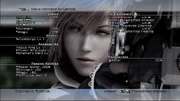
Lightning's stats in Final Fantasy XIII.
Each party unit has their own set of stats, which all affect different aspects of the battle. Some stats are primary stats and are just raw stats, others are secondary and are calculated based on primary stats and equipment. Most stats are raised by leveling up, and some are raised by specific items. Accessories also impact stats.
Some abilities can affect stats, for example, Dischord halves the level of its target, and all the stats which are effected by the level, and Haste, which affects the Speed.
Elements
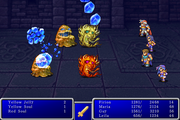
Blzzard is an ice-elemental spell.
Each enemy unit has its own set of elemental affinities. Most of the time, elements will remove a standard amount of damage, however units can be weak to it and endure more damage, they can halve the damage dealt by it, be resistant to it and lose no health, or they can absorb it, which means they gain damage from the element. Some games use a simple general system where Fire is strong against Ice and vice-versa, and Lightning is strong against Water and vice-versa. Other games use a more complex system with up to nine elements that affect different types of enemy. Robots are often weak to Lightning and the Undead are weak to Holy, and sometimes also Fire.
A number of weapons are elemental, such as the Flametongue for Fire, and Icebrand for Ice. Armor can protect against or absorb elements, as can some accessories.
Status effects
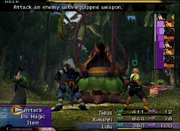
Tidus poisoned in Final Fantasy X.
The battle system is rife with status effects. Some status effects affect the party members' stats, such as Haste and Slow affecting the Speed stat and therefore changing how many turns they get, and Blind heavily reducing the hit rate. Silence stops targets from using MP consuming abilities and various other abilities, usually limiting a unit to its standard commands, Attack, Item, Defend, and Row.
A number of status effects have both negative and positive effects. Berserk limits a unit to just the basic Attack ability. However, attacks are stronger. A negative status, Confusion removes all control of a unit and they attack either both parties randomly, or just their own ally party.
Some characters fall into a status depending on their HP. When their HP is 0, they are in the Knocked Out status and must be revived by another ally. When a unit has below a certain percentage of their HP remaining they enter the Critical status which makes their HP turn yellow, and their pose often changes. Positive effects of this status are different depending on the game. In many games units with the Cover support ability will protect an allied unit in Critical, and in some games, the Critical status is when the Limit Break system can come to life. A notable status is All Lucky 7s in Final Fantasy VII which is entered when a player has exactly 7,777 HP. When a character enters the status they will do a sequence of 63 attacks for exactly 7,777 damage, and take 7,777 damage for every attack after while in this status.
Often individual units will have their own statuses. Vincent's Limit abilities in Final Fantasy VII have him morph into different forms, give a loss of player control, and change many stats. The Guard Scorpion of Final Fantasy VII has two statuses. Its normal status is encountered normally, and its alternate status is when it raises its tail where its movement changes and it gains a new counter ability.
While status effects were designed for battle, some have an effect out of battle. Float can allow players to move over Damage Floors without damage, and Poison can cause a player to take damage for every step.
Equipment
Equipment is a feature only available to the party in most games. Equipping the party members with the range of equipment is one of the simple systems which develop the character. Types of equipment are usually specific to a number of characters, where Mages and similar jobs wear light armor and equip weaker weapons, where offensive job classes have stronger weapons and equip heavier armor. Games where the characters can switch their job class usually also have a job class that can equip anything, such as Onion Knight from Final Fantasy III, and Freelancer from Final Fantasy V.
Basic equipment categorized by their material can usually be found in Shops such as the Bronze equipment, and Mythril equipment. Unique weapons elemental like the Flametongue, or otherwise like the Blood Sword, are often found in dungeons.
Weapons
Weapons are the attacking force of the player party in the series. Weapon types range in their purposes. Bows, Crossbows, and Guns are designed for long-distance attacks. Axes, hammers and the variety of swords are meant for physical attack. Many weapons are designed for specific job classes, such as staves and rods for Mages, spears for Dragoon, unarmed, gloves, and claws for Monks, and cards and dice for Gamblers. Most games assign a particular type of weapon to a character or types of weapon to job classes. An exception to the rule is Final Fantasy II where every character can use and master any weapon.
Armor
Armor is divided into different groups in different games. Job class games often have a number of different weight classes. There are also different types of armor depending on its placement on the body, such as body armor, helmets, and shields, where some other games limit it just to body armor. Heavy armor is often used by Warriors, Dragoons, and Berserkers. Units are slowed down by its weight, has no evasion effector, but has high defense. Light armor can be used by most job classes, weighs less, has no evasion effector, and has slightly less defense. Robes can be used by Mage job classes, has less defense, weighs less, but has high Magic Defense and Magic Evasion stats.
In games without job classes, all characters often have access to all armor.
Accessories
Accessories each have their own ability. They can increase a unit's stat, protect against statuses, and decrease the effect of, cancel the effect of, or absorb elements. They can also grant support abilities like automatic statuses, and increase rates. Accessories can often by equipped by every player unit.
Summon
A common ability in many entries to the series, Summon calls the assistance of another unit during battle. This unit is not part of the enemy or player party, but a unique entity involved only in its calling. Earlier games of the series just used summons as an ability which called upon a sequence, for a higher MP cost than normal spells, but for a greater effect. Later installments have integrated summons into different aspects of the battle. In Final Fantasy VIII, when a player selects the "GF" command and the summon, the "Guardian Force" imposes their name over the user's name, and the GF's own HP replaces the unit's HP and takes all damage made to the player unit instead of the player unit their self. If their HP hits 0 before the ability is used, the summon is not called. Furthermore, each character has a compatibility with the individual Guardian Force summons, and the Guardian Force give their abilities to the players, essentially meaning the GF system controls most of the battle system since players only have access to the Attack and Item command without them.
Final Fantasy X evolved this system with its Aeon system. Aeons summoned into battle would replace the player party, and when the summon was withdrawn or had their HP reduced to 0, the player party would return. Each Aeon has their own set of commands and "Overdrive", essentially making them playable characters. In this game, each summon is assigned a character whose development directly effects the Aeon's.
Limit Break
The Limit Break system was an addition made to the Final Fantasy series in Final Fantasy VI, known then as a Desperation Attack. Desperation Attacks were part of a simple system where a character has a chance to perform their Desperation Attack, a unique ability to them. The simple system developed into the Limit Break system of Final Fantasy VII that added a development system to Limit Breaks where the amount of times certain Limit Breaks are used or the amount of enemies killed or specific items would allow the character's to learn new Limit Breaks. The Limit Breaks are tiered over four levels, two for each except their final Limit Break for LEVEL 4. The ability to use Limit Breaks appear when the character's LIMIT gauge fills after being hit, using a similar system, but less open to player's abusing it by keeping their player's in critical. Final Fantasy IX reuses a gauge system, but the player loses the control to use the command, instead "Trance" occurs instantly when the gauge is full.
In Final Fantasy VIII, the player returns to the old system of being in Critical. Each character is given their own Limit Break system, such as Quistis's Blue Magic style, and Zell's button input within a certain time. If the player is in Critical, they can keep canceling their turn to refresh it to give another chance of the Limit Break command being available.
Final Fantasy X uses a gauge that is filled in different ways, set by Overdrive Mode. Much like Final Fantasy VIII, each character has their own system, such as Lulu using a different amount of spells matching the amount of times the analogue stick is rotated, and Auron having to press the action button when the slider moves into a certain position.
Critical hits
Critical hits are an increased damage strike on the enemy. In some games, a critical hit ignores the target's defense, allowing the player to deal normal damage to Flan type enemies. In some games, critical hits only apply to certain weapons. Attacks can also achieve critical hits.
Enemy sourced abilities
In the series, there have been many occurrences of using or learning abilities originally used by enemies, taught by enemies, or utilized from enemies. The most common form used in most games is Blue Magic under one of its many guises. Blue Magic is a skillset that stores abilities learned from enemies. The advantages of using Blue Magic is it can grant access to stronger abilities than would sometimes be available, and they generally have lower MP costs in comparison to similar spells. It also grants access to special attacks that wouldn't otherwise be available in the other Magic skillsets.
There have been a number of different methods used throughout the series to learn these abilities. One of the most common methods is for the player with the skill to be attacked by the ability. This method usually takes longer in some situations where the enemy is reluctant to use the ability, and doesn't always use it on the character with the ability. Some enemies will only use the ability under certain circumstances, such as Chocobuckle from Final Fantasy VII, and in some games enemies may never normally use the ability, or use the ability on the player party in regards to restorative spells. These abilities are only available to the player if they use Control. The other common method used is to learn the abilities from specific enemies with a command, such as Kimahri's Lancet command in Final Fantasy X, and Quina's Eat or Cook commands in Final Fantasy IX. While Lancet in Final Fantasy X can be used on any enemy at any point and guarantee the learning of the spell, Eat in Final Fantasy IX requires the target to be in the Critical status beneath a percentage of their max HP for it to succeed, while Cook allows a higher perecentage of the Max HP to be remaining. Due to this, enemies don't technically need to possess the ability for the player to learn it from them. In Final Fantasy VIII, Quistis learns her abilities through items dropped by enemies.
In some games, enemy abilities can be permanently missed if all enemies that are sources of the enemy ability are bosses or only encountered in unrevisitable locations.
Other methods of enemy sourced abilities exist, usually parallel to Blue Magic. The Catch command allows players to catch individual enemies, and then use the Release command to release them to do an attack on the enemies. Only one enemy can be "caught" at a time and caught enemies are kept until they are released. The Catch command will only be successful if the enemy in a low enough level of the Critical status.
Sketch in Final Fantasy VI allows its user to use an attack of the targets against the target if the ability is successful. The Rage skillset allows the user in the same game relinquishes the player control and has a fifty-percent chance of using one of the enemy's attacks on their turn. The Leap command appears when the player is on the Veldt, and the battle will end and the character with the command will leave the party. When they return at the end of a later battle, the character will add the enemy they used Leap on, in addition to all the enemies who were in the battle he returned in.
The Draw and Cast commands in Final Fantasy VIII allow the player to use an enemy's spells on itself immediately. They can also be stocked for use later on.
Control
Control allows the user to take control of a target in the enemy party if the command is successful. On the player's turn, the player will be able to select a command from a list of attacks that the enemy will use. This allows for easier learning of, and in some cases, necessary to learn, Blue Magic abilities. It can also be used to stop a particular enemy from being able to attack, and it can be used so weaker enemies can knock down small amounts of HP, particularly useful in Final Fantasy VII to obtain a HP count ending in 77 to help achieve the All Lucky 7s status.
During the control, the the player controlling the enemy cannot attack. Units in the Control status will fall out of the Control status when it is attacked. The user cannot use it on a member of its own team, and no enemies have this ability, meaning its a player exclusive ability and an enemy exlusive status.
In Final Fantasy VII during a battle against two SOLDIER:2nd enemies, if one is manipulated, the other will counter, and the other will counter the counter and this continues until one loses all its HP.
Inventory
The Item command is available in most entries to the Final Fantasy series, appearing at the bottom of the Command window. Labeled a skillset, with its abilities being classed as the usable items, known as Use items, the Item command allows the user to spend items from their inventory to gain an effect in battle. With the exception of Tent and other items only available at Save Points, all recovery items can be used during battle. A number of offensive items are also available, usually inflicting both positive and status effects. Most games also assign multiple items to each key element, for example the Antarctic Wind, Arctic Wind, and White Fang usually deal ice-elemental damage comparable to Blizzard, Blizzara, and Blizzaga respectively.
In some games, the health restored from restorative items is specific, which makes it easier for the player to land on a specific number. In Final Fantasy VII, All Lucky 7s can be achieved easily by getting a character to have their HP end in the digits 77. After this, they can use a number of types of Potions to restore to 7,677 HP, and using a Potion immediately in the next battle to guarantee achieving the status.
Some items with their primary use being used in the field also serve a purpose in battle, such as the Dead Pepper from Final Fantasy IX, and the Greens from Final Fantasy VII.
The Throw command allows items from the player's inventory to be spent on damaging the enemy. The Throw command specifically allows the player to throw unequipped weapons to inflict damage to the enemy based on the weapon's attack, and also the user's Level and Strength depending on the game. In addition, usually a number of Shuriken items that have no other purpose than the Throw command can be thrown.
Another method the inventory has an effect on the battle is through the Auto Potion support ability, that causes the user with the ability equipped to use a Potion from the user's inventory when they are attacked. A similar ability, the Auto-Phoenix ability does the same for Phoenix Down items when they fall into the Knocked Out status in Final Fantasy X.
The Mix command allows the player to select two items from their inventory to create a new item the player uses instantly. While many of these items are also available as inventory items, the better outcomes are usually unique abilities to the Mix command. The result of the command usually depend on the two items picked, and the order they are placed.
Steal
Items are further involved in battles through treasures kept by enemies. These items can be retrieved from them and added to the player's inventory through use of the Steal command. The Mug command which appears in some games is another method which attempts to steal the item, and inflicts additional damage. Some games assigns enemies with the Steal command, or similar commands, which allow them to steal an item from the player's inventory. Furthermore, these enemies are also equipped with the Escape so the player can permanently use the item. If the enemy is defeated before escaping, the item is returned to the player's inventory.
Enemy's items work in different ways in different games. In many games, each enemy has a common and rare steal, whereas in others enemies may have a number of different items, all at different steal rates and in different priorities. Certain equipment can increase the chance of a successful steal, such as the Thief Gloves.
Poach
The Poach command allows players to instantly defeat units with a certain level of Critical HP, and those not immune, and receive an item. In some games, the Poach command inflicts a smaller amount of damage than an average attack, and if the strike reduces the enemy's HP to 0, they are defeated and the item is received. Items received are often rarer, such as the Guide Book, an item only only available by successfully beating the Ghost Ship using the command in Final Fantasy VII.
Gil
Some abilities allow for the amount of Gil spent on the attack to contribute to the damage the attack will do. The most common way of doing this is using the Gil Toss ability. In Final Fantasy X, the Yojimbo summon uses this method to contribute to the decision of which of the five abilities he does, including both variations of Wakizashi, to one unit and to all enemy units.
The Bribe command allows the player to spend an amount of Gil to retrieve items from the enemy. If a specific amount is given, the enemy will leave the battle and the player will get an item. Items retrieved from this are usually rare.
Limits
Limits, or caps, refer to a max output number that cannot be exceeded through ordinary means. The term occurs most often with Damage, HP, MP, and Level, but there are other limits present in games such as Gil, 99 of an item, or 100 or 255 with a particular stat. Ordinarily, Damage and HP are capped at 9,999, MP at 999, and Level at 99, however there have been instances of capping at Level 100. During most situations, the game won't allow the player to do anything that would ordinarily increase a figure that has already reached its limit, however some games allow the player to waste things, such as items, even when a maximum is reached, such as the source items of Final Fantasy VII.
Some things are naturally designed to not be limited by a cap. An example of this is Eden from Final Fantasy VIII. Crisis Core -Final Fantasy VII- is notable for allowing the limits for HP, MP, and SP to be exceeded when a player gets a successful combination in the DMW. However, if the limits are at 9,999, 999, and 999 respectively, they will not be broken.
Damage limits can unnaturally be broken when there's a damage overflow, such as killing a large number of enemies makes the Death Penalty an instant kill weapon, and equipping a great number of AP to the Missing Score weapon does the same, both in Final Fantasy VII.
There are a number of support abilities that allow some of the limits to be broken, but these abilities just extend the cap to another digit more. These are called Break Damage Limit for damage, extending the cap to 99,999, Break HP Limit for HP, extending the cap to 99,999, Break MP Limit for MP, extending the cap to 9,999, and Break AP Limit for AP, extending the cap to 9,999. In Final Fantasy VII, the caps for MP and HP can be exchanged for a 9,999 MP cap and a 999 HP cap by equipping the HP<->MP Materia.
Other special attacks
A number of abilities use non-logical mechanics to determine the outcome. Examples include Chocobuckle from Final Fantasy VII that take off damage based on the amount of battles escaped from. The ultimate weapons of Final Fantasy VII are based on different things, including how full the Limit gauge is, the closeness to maximum HP or MP of a character, and the amount of kills done with the weapon.
There are also Level based attacks that only connect with targets with a level divisible by the specified number. Due to the Level 100 maximum in Final Fantasy VIII, Level 5 Death will defeat all enemies if they are at maximum level. A number of attacks reduce player's HP to single-digit, or low HP. In some games these are considered Gravity elemental, however in others it isn't treated as an element. A number of spells, including Death, are classified as instant death attacks. Also aerial enemies, essentially in a Float, can avoid earth attacks.
Other systems
Individual games use systems unique to them. In Final Fantasy VI, Gau and Gogo can use the Rage command that opens up a menu with 252 possible commands, all based on enemies from whom they can be taught. When a character uses a Rage, they are granted status effects, status immunities, and elemental affinities. The player loses control of the character and they will have a fifty-percent change of using a normal physical attack on their turn, and a fifty-percent chance of using a specific ability, originally used by the enemy it was taught from.
In Final Fantasy VIII, the game revolves around a Draw system, both in and out of battle. Its use in battle is to stock up on the enemy's spells, cast the enemy's spells against them, and, for a number of bosses, to draw GF from them. The GF drawn from bosses are permanently missed if they are not drawn from the boss, however, if they are missed from the original bosses, a number of bosses in Ultimecia Castle also have the GF. Final Fantasy VIII is also home of the trigger for Squall's Gunblade. When Squall strikes an enemy, a timed R1 press guarantees a critical hit. This can also be used in his Renzokuken Limit Break. The Devour command in Final Fantasy VIII allows the player to "eat" enemies for negative or postive effects depending on the enemy. It will only work on a target in a certain level of the Critical status.
Conclusion
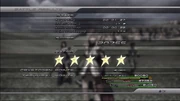
Battle Results screen in Final Fantasy XIII.
The outcome of an ordinary battle is either a victory, followed by its rewards, or a defeat, followed by Game Over. However, different battles demand different things from the player, and defeating the entire enemy party isn't always the target battle. It is not possible to defeat some enemies, and the idea of the battle is to be defeated.
Victory
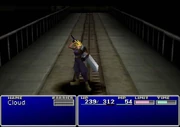
Cloud's victory pose in Final Fantasy VII.
A victory is usually earned when the entire enemy party is defeated. After this the player will be rewarded with Experience Points, Ability Points, Gil, and any items dropped. Sometimes an alternate victory is achieved by satisfying the enemy's needs, such as PuPu in Final Fantasy VIII, or defeating all enemies except the Golem in Final Fantasy V. Usually these methods will result in different outcomes, such as the PuPu Triple Triad card, or the Golem summon respectively.
Game Over
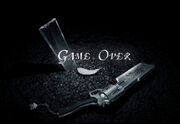
Game Over in Final Fantasy VIII.
A Game Over is received when the entire player party is defeated. A Game Over can also be received during battles where there is a unit on the enemy party the party is supposed to keep alive, for example Rinoa during the Adel battle.
Nonfatal defeat
A nonfatal defeat is a battle the player party is forced to lose, or doesn't have to win. The Black Knight battle at the start of Final Fantasy II is intended to be lost. In Final Fantasy VIII the player can't get a Game Over against the first boss battle with Edea, but if they deplete her HP to zero before the battle ends, they get items and AP. During the battles against Beatrix and Kuja in Final Fantasy IX, the party is supposed to be overpowered before being defeated. In Final Fantasy X, the player can lose to Belgemine's Aeons without it being classed as a defeat.
Musical themes
There are three notable battle themes in the games. The normal Battle Theme against normal encounters, the Boss Theme against boss enemies, and the Final Boss Theme against the Final Boss of the game. Often other bosses are fought with their own battle themes, and sometimes music from the field overflows into the battle instead of playing a battle theme, such as "Dust to Dust" continuing playing during battles in Oerba in Final Fantasy XIII instead of changing into the regular battle theme. Other special battles often have their own theme such as the Friendly Enemies in Final Fantasy IX.
The Victory Fanfare is a notable piece in the Final Fantasy series that plays after the player victors in a battle.
Template:Miscellaneous
